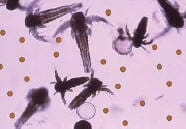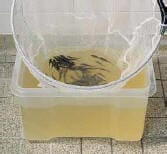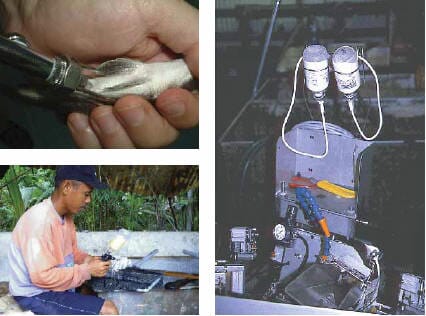
The culture environment, be it in tanks, cages or ponds,
seawater or freshwater, can stress the fish due to high stocking densities, reduced oxygen levels,
sub-optimal water quality and high pathogen loads. Therefore, farmed fish, similar to farmed animals,
have an increased susceptibility to infectious diseases. Such diseases may be bacterial, viral, fungal
or parasitic in origin.
Prophylactic treatments and good management practices can usually
prevent or reduce the susceptibility to diseases. Although, antibiotics
can overcome bacterial diseases, consumer health and food safety
issues prevent their use in aquaculture. Moreover, established viral
diseases cannot be treated.
 Therefore, vaccination is the best alternative to combat bacterial
and viral diseases. It has been a key tool in the success of the livestock,
pig, poultry and salmon industries in the fight against infectious
diseases. In salmon farming, the use of vaccines is now so routine
that all fish stocked in sea cages are vaccinated. It has been proven
to be cost effective. It is also the key reason for the success of that
industry.
Therefore, vaccination is the best alternative to combat bacterial
and viral diseases. It has been a key tool in the success of the livestock,
pig, poultry and salmon industries in the fight against infectious
diseases. In salmon farming, the use of vaccines is now so routine
that all fish stocked in sea cages are vaccinated. It has been proven
to be cost effective. It is also the key reason for the success of that
industry.
However, in Asia, fish vaccination is still a new concept that is
not very well known and understood among farmers and professionals
working in the area.
What are vaccines?
 For oral vaccination, antigens are incorporated in feed |
Vaccines are various preparations of antigens derived from specific
pathogenic organisms that are rendered non-pathogenic. They stimulate
the immune system and increase the resistance to disease from
subsequent infection by the specific pathogen.
Vaccination can be compared with an insurance policy where it
is worth paying a basic fee for a policy that would later cover the costs
of a more expensive disease or accident that may occur. Similarly,
vaccination is a preventive measure that protects fish against a future
disease and the associated costs due to morbidity, mortality and
therapeutic treatment.
However, just as an insurance policy will cover
the costs of an accident only if this fits the clauses of the insurance
contract, a vaccine only protects against specific diseases. For
example, a vaccine against Streptococcus iniae infection will protect
the vaccinated fish against Streptococcus iniae but it will not protect
the fish against Vibrio anguillarum.
A vaccine can be either water or oil
based. Typically, injection vaccines are
oil based as the oil provides adjuvant
qualities. This means that the oil
increases the effectiveness of the
vaccine as well as the duration of the
desired protection.
The choice of vaccine depends on
the particular case. It will depend on
whether protection can be obtained,
the duration of the protection possible
versus the required duration, the final
cost of the vaccine in relation to the
benefit to the farmer and the registration
limitations imposed by authorities in the
countries where the vaccine is marketed.
There are three major modes for the application of vaccines: oral,
immersion and injection. However in all cases, only healthy fish should
be vaccinated as it is a preventive measure and not a cure.
Oral vaccination
With oral vaccination, the vaccine is either mixed with the feed, coated
on top of the feed (topdressed) or bio-encapsulated. When antigens
are to be incorporated in feed, the heat sensitivity of the antigen has
to be considered. When vaccines are used as top dressing in feed, a
coating agent is usually applied, either to prevent leaching of the
antigen from the pellets or to prevent breakdown of the antigen in the
acidic environment of the fish stomach. For sensitive antigens, various
microencapsulation methods are being evaluated and tested.
Bio-encapsulation is used where fish fry are to be vaccinated.
In this case, live feed, such as Artemia nauplii, copepods or rotifers,
are incubated in a vaccine suspension after which they are fed to the
fry. Since these live organisms are non-selective filter feeders, they
will accumulate the antigen in their digestive tract and as such,
transform themselves into living microcapsules.
Oral vaccination has the advantage that it is a very easy vaccine
administration method with no stress to the fish. However, oral
vaccines have a very short term stability once mixed with the feed.
In most cases, only limited protection can be obtained and the duration
of protection can be rather short. Moreover, although oral vaccination
is the preferred method from a fish farmers perspective, at present
there are few, if any, effective oral vaccines in the market.
Immersion vaccination
 Artemia in vaccine solution (orange dots represent vaccine antigen) |
Skin epithelium and gills have mechanisms to protect fish in a broad
as well as specific way. Immersion vaccination works on the ability
of mucosal surfaces to recognize pathogens they had been in contact
with. When fish are immersed in water containing the diluted vaccine,
the suspended antigens from the vaccine may be adsorbed by the
skin and gills. Then, specialised cells, such as antibody-secreting
cells, present in the skin and gill epithelium will be activated and will
protect the fish when fish are exposed to the live pathogen at a later
stage. Other cells located in the epithelium of skin and gills, such as
antigen presenting cells (macrophages), also absorb vaccine antigens
and transport them to specialised tissues where the systemic immune
response builds up.
In immersion vaccination, there are two application methods: dip
and bath. In dip vaccination, fish are immersed for a very short
duration, usually 30 seconds, in a highly concentrated vaccine solution,
usually 1 part vaccine product to 9 parts water. With bath vaccination,
fish are exposed for a longer period, usually one to several hours, in
a lower concentration of vaccine.
 Dip vaccination |
It has to be noted that, in fish smaller than 1g, the immune system might still be immature and, therefore, the vaccine efficacy may be reduced. A few bacterial combination vaccines exist for immersion application but, to our knowledge, no inactivated viral vaccine is presently available for immersion application.
Injection vaccination
Initially, fish farmers may not favour injection vaccination
as they fear that the stress resulting from the handling and
injection of the fish will cause high mortality. In contrast,
many studies and farmers experience in the salmon industry have
shown that there is no mortality associated with the vaccination process
per se, although some weak fish may die due to the handling process.
Light anaesthesia of fish is needed for injection vaccination. This
decreases the stress due to vaccination, prevents mechanical injuries
and helps the fish to recover faster from the handling. When injection
vaccination is performed properly, mortality immediately after vaccination
should not exceed 0.25%. Higher mortalities indicate incorrect use of
anaesthetic, excessive handling/stress of the fish, incorrect needle
insertion (e.g., rupturing the spleen), vaccination of diseased or
weakened fish, lack of oxygen in the anaesthesia vessel, etc.
Injection vaccines can be administered by intramuscular or
intraperitoneal (in the abdominal cavity) injection, but the latter is
by far the most common. As intraperitoneal injection vaccination
involves depositing the vaccine in the abdominal cavity, it is important
that the needle should penetrate the targeted abdominal wall of fish
by 1 to 2 mm. Short needles might deposit the vaccine in the
musculature and cause inflammation and a bad immune response.
The right thickness of needle is also important. If the vaccine is
viscous, it might pass through the needle with difficulty. In contrast,
a needle that is too large can induce sores and secondary infections
at the injection site, and allow the vaccine to flow back.
The rapidity of the immune response is temperature dependant.
It usually takes several weeks before good immune protection is
developed as a result of vaccination. Therefore, it is important not
to stress the fish in the weeks following vaccination as stress is known
to suppress the immune system.
Injection vaccination has a number of major advantages that makes
it a preferred vaccination method. Injection vaccination provides for a
long duration of protection, i.e., for over a year, and it allows for multiple
antigens to be combined in a single vaccine and, therefore, in a single
administration. In addition, the fish farmer is assured that every fish
in the population has received the vaccine and at the correct dose.
At present, the most complex products provide protection against
6 antigens (5 bacterial and 1 viral) and, in the near future, heptavalent
vaccines will become available. The injection volumes per fish are
usually 0.1 or 0.2 ml and give protection throughout the production
cycle of most farmed species. Injections are in general superior to
any other vaccine application method; however, from a practical point
of view, they can only be applied to fish of 10g or more.
Summary
Although oral vaccination is the most
practical method for fish farmers and
may be less stressful for the fish, it
is also the least effective method of
vaccination. Immersion vaccination
gives a good protection for up to
several weeks or months and is usually
used to vaccinate small fish of 15g
to protect them until they are big
enough to receive an injection
vaccination. The injection vaccination
is the best vaccination method in
terms of duration of immunity and
efficacy of protection. It usually
protects fish until market size.
Just like in the salmon and
livestock industries, vaccination will
become a critical factor for
economically viable and sustainable
aquaculture in Asia. However, it is
important to realise that it is only the
combination of vaccination with
several other factors, such as high
quality seed, good nutrition, good
management and good husbandry
practices that can assure the highest
possible survival rate and the best
profit margins.
 |
Different types of vaccines exist:
- Inactivated vaccines are the most common in aquaculture. They are produced by inactivating
the disease-causing micro-organism with chemicals or heat.
- Live, attenuated vaccines. To make a live, attenuated vaccine, the disease-causing microorganism
is grown under special laboratory conditions that cause it to lose its virulence
or disease-causing properties. Intervets Aquavac ESC, a vaccine used against Edwardsiella
ictaluri in Channel catfish (Ictalurus punctatus) in the USA is an example.
- Subunit vaccines are a more modern type of vaccine, developed from antigenic fragments
that are able to evoke an immune response. Subunit vaccines can be made by purification
of parts of the actual micro-organism or they can be made in the laboratory using genetic
engineering techniques. An example is Intervets Compact IPN used against infectious
pancreatic necrosis virus infections of salmon in Chile.
- Recombinant vector vaccines. A vaccine vector or carrier is a weakened bacterium into
which harmless parts of genetic material from another disease-causing micro-organism
have been inserted.
- DNA vaccines are developed using plasmids containing information on the expression (of
part) of the antigen of interest.
- Synthetic/peptide vaccines are synthetically prepared antigenic epitopes in a suitable
carrier or adjuvant.
- Anti-idiotypic vaccines contain antibodies developed so as to mimic an antigen.
June 2006

